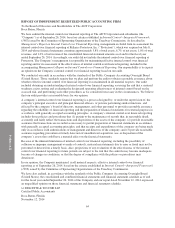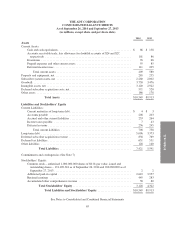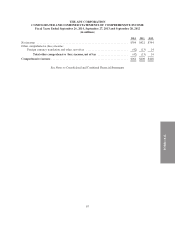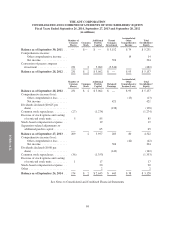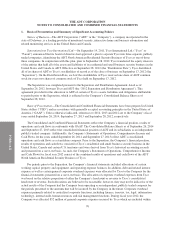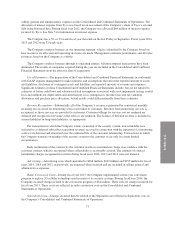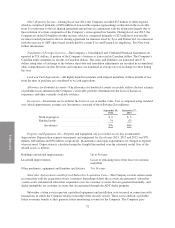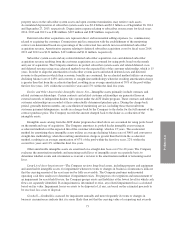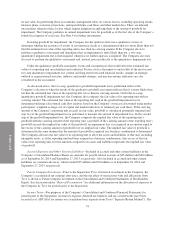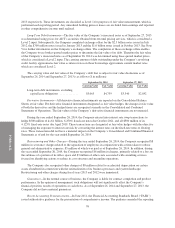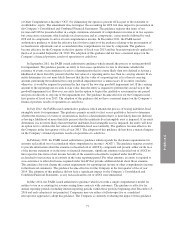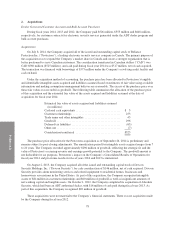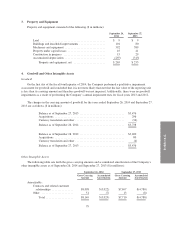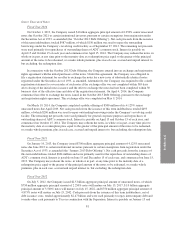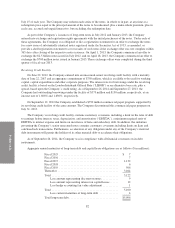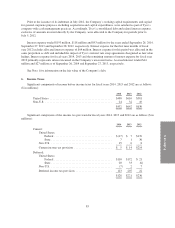ADT 2014 Annual Report Download - page 139
Download and view the complete annual report
Please find page 139 of the 2014 ADT annual report below. You can navigate through the pages in the report by either clicking on the pages listed below, or by using the keyword search tool below to find specific information within the annual report.
FORM 10-K
property taxes on the subscriber system assets and upon customer termination, may retrieve such assets.
Accumulated depreciation of subscriber system assets was $2.4 billion and $2.2 billion as of September 26, 2014
and September 27, 2013, respectively. Depreciation expense relating to subscriber system assets for fiscal years
2014, 2013 and 2012 was $381 million, $325 million and $287 million, respectively.
Deferred subscriber acquisition costs represent direct and incremental selling expenses (i.e. commissions)
related to acquiring the customer. Commissions paid in connection with the establishment of the monitoring
contract are determined based on a percentage of the contractual fees and do not exceed deferred subscriber
acquisition revenue. Amortization expense relating to deferred subscriber acquisition costs for fiscal years 2014,
2013 and 2012 was $131 million, $123 million and $111 million, respectively.
Subscriber system assets and any related deferred subscriber acquisition costs and deferred subscriber
acquisition revenue resulting from the customer acquisition are accounted for using pools based on the month
and year of acquisition. The Company amortizes its pooled subscriber system assets and related deferred costs
and deferred revenue using an accelerated method over the expected life of the customer relationship, which is 15
years. In order to align the amortization of subscriber system assets and related deferred costs and deferred
revenue to the pattern in which their economic benefits are consumed, the accelerated method utilizes an average
declining balance rate of 245% and converts to straight-line methodology when the resulting amortization charge
is greater than that from the accelerated method, resulting in an average amortization of 59% of the pool within
the first five years, 24% within the second five years and 17% within the final five years.
Dealer and Other Amortizable Intangible Assets, Net—Intangible assets primarily include contracts and
related customer relationships. Certain contracts and related customer relationships are generated from an
external network of independent dealers who operate under the ADT dealer program. These contracts and related
customer relationships are recorded at their contractually determined purchase price. During the charge-back
period, generally thirteen months, any cancellation of monitoring service, including those that result from
customer payment delinquencies, results in a charge-back by the Company to the dealer for the full amount of the
contract purchase price. The Company records the amount charged back to the dealer as a reduction of the
intangible assets.
Intangible assets arising from the ADT dealer program described above are accounted for using pools based
on the month and year of acquisition. The Company amortizes its pooled dealer intangible assets using an
accelerated method over the expected life of the customer relationship, which is 15 years. The accelerated
method for amortizing these intangible assets utilizes an average declining balance rate of 300% and converts to
straight-line methodology when the resulting amortization charge is greater than that from the accelerated
method, resulting in an average amortization of 67% of the pool within the first five years, 22% within the
second five years and 11% within the final five years.
Other amortizable intangible assets are amortized on a straight-line basis over 5 to 40 years. The Company
evaluates the amortization methods and remaining useful lives of intangible assets on a periodic basis to
determine whether events and circumstances warrant a revision to the amortization method or remaining useful
lives.
Long-Lived Asset Impairments—The Company reviews long-lived assets, including property and equipment
and amortizable intangible assets, for impairment whenever events or changes in business circumstances indicate
that the carrying amount of the asset may not be fully recoverable. The Company performs undiscounted
operating cash flow analyses to determine if impairment exists. For purposes of recognition and measurement of
an impairment for assets held for use, the Company groups assets and liabilities at the lowest level for which cash
flows are separately identified. If an impairment is determined to exist, any related impairment loss is calculated
based on fair value. Impairment losses on assets to be disposed of, if any, are based on the estimated proceeds to
be received, less costs of disposal.
Goodwill—Goodwill is assessed for impairment annually and more frequently if events or changes in
business circumstances indicate that it is more likely than not that the carrying value of a reporting unit exceeds
73



